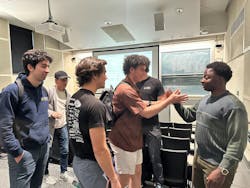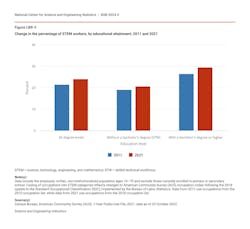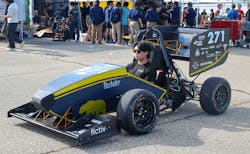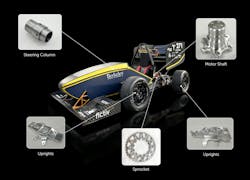National Manufacturing Day Paves the Way for Next Generation of Manufacturers
At a Glance:
Manufacturing Day (MFG Day), an initiative of the Manufacturing Institute, draws attention to opportunities in modern manufacturing by fostering interest in manufacturing careers. This year, on Oct. 4, organizations across the nation plan to showcase the part they play in this flourishing industry. More than 3,000 events are planned across 50 states and Puerto Rico.
Machine Design had the pleasure of joining Industry Week's Production Pulse panel this week to discuss how industrial companies can recruit future workers and some of the challenges they face in doing so.
For his part, and in celebration of National Manufacturing Day, Dave Evans, CEO and co-founder, Fictiv, offers up-and-coming engineers a word of advice on the value of STEM education and solutes the UC Berkeley students behind an electric race car project. Known for its digital supply chain tools, Fictiv simplifies manufacturing capabilities and sourcing of custom mechanical parts.
You’re a young engineering student trying to learn the ropes. You’ve got more enthusiasm than experience, but you’re open to new ideas. National Manufacturing Day is a great time to think about how we can raise awareness of the industry and give students exciting reasons to explore a career in manufacturing. Today, there are so many opportunities for designing, building and innovating for the future—especially for the next generation. From surgical robots to satellites to electric vertical take-off and landing (EVTOL) vehicles, it’s an exciting time to be in manufacturing!
STEM (science, technology, engineering and math) education plays a significant role here. I didn’t know the history of STEM, so this year, I thought I’d do a bit of research to learn more (thank you, AI). STEM education in the U.S. emerged in response to the 1957 Sputnik crisis, leading to increased federal investment in science and math education through the National Defense Education Act of 1958. The focus expanded in the 1980s and 1990s with reports like “A Nation at Risk,” pushing for stronger math and science curricula.
READ MORE: Boosting Welding Education: AWS Foundation Supports Schools to Train Skilled Welders
The term “STEM” gained prominence in the early 2000s, championed by the National Science Foundation, and the 2007 America COMPETES Act further promoted STEM education. By the 2010s, national initiatives like “Educate to Innovate” emphasized improving participation and diversity in STEM fields, with a growing focus on aligning education with workforce demands in fields like AI and renewable energy.
Since the 1990s, U.S. rankings for math and science globally have improved somewhat, though not as much as hoped. Awareness of STEM education has grown over the years, along with an emphasis on inclusion, sustainability and increasing opportunities for women. And of course, STEM skills are essential for many roles in manufacturing.
The State of STEM in the U.S.
According to the National Science Foundation (NSF), the U.S. ranks 25th in mathematics literacy among the 37 countries in the Organisation for Economic Co-operation and Development (OECD). It fares better in science, ranking seventh. In computer and information literacy, the U.S. ranks fifth out of the 14 education systems assessed. These rankings highlight areas where improvement is needed, particularly in mathematics, to ensure global competitiveness.
And while U.S. performance in STEM subjects globally has been mixed, progress has been made. The impact of STEM education on workers in related fields increased significantly between 2011 and 2021.
The connection between STEM education and the workforce is significant. The U.S. Bureau of Labor Statistics indicates that there is a projected need for about 1 million more STEM professionals over the next decade to maintain the nation’s leadership in science and technology.
But there’s no substitute for hands-on experience and mentorship. This kind of experience will do as much or more to build a robust American manufacturing economy than classwork.
Hands-on Inspiration for Future Manufacturing Engineers
Improving global competitiveness is clearly a work in progress, but for the engineering and math students at U.C. Berkley, progress is measured in EV race cars. Formula Electric Berkeley is a student-run club determined to apply their classwork to real-world experience. Every year, teams of university undergraduate and graduate students conceive, design, fabricate, develop and compete with small, formula-style vehicles in a race run by the Society of Automobile Engineers (SAE).
READ MORE: The View from the Frontline: Separating Robotics Hype from Reality
The students’ enthusiasm for designing, manufacturing and assembling their race car was a life-changing experience, shining a light on the importance of real-life learning to round out their education. For these young engineering students and their mentors, this was a once-in-a-lifetime experience.
According to one of the students, “participating in the team project and watching the final car pass inspection was one of the most exciting moments of my life.”
The Importance of Mentorship
Mentorship has had a huge impact on my career—and those mentors were not always people I had met in person. I’ve learned so much from successful businesspeople, coaches and teachers. It’s not surprising that the Berkeley students were equally inspired by their work in the Formula Electric Berkeley club.
At each phase of the project (especially design for manufacturability guidance) the students relied on manufacturing mentors to show them how to apply classroom learning.
Design for Manufacturability Guidance
In this case, the students’ mentor taught them how to prepare their designs for manufacturing. In previous years, they tried manufacturing sockets and splines in-house but ran into roadblocks when the intended design didn’t match the result. Several long phone calls later, they partnered with another manufacturer and mentor who took them through the DFM process. Ultimately, this partnership helped manufacture the uprights, shafts, columns and sprockets for the assembly.
“Mentoring the students at Berkeley was so exciting,” said a technical applications engineer who helped guide the students. “Seeing their enthusiasm, energy and curiosity was inspiring and worth all the effort we put into this project. If I could teach students like this about engineering, I’d do it every day. I’ll always be proud of being involved in their journey.”
Advice for Future Manufacturers
Hands-on experiences like these are invaluable opportunities to apply classwork to the real world and give students a critical head start—especially in manufacturing. Since one of the goals of National Manufacturing Day is to encourage people to consider entering the field, here are some key pieces of advice that have helped me along the way.
Understand the basics of each manufacturing process. Each process has a different set of design rules and functions it can perform well. Learn these first so you don’t have to do as much redesigning after talking to the tool makers or machinists.
Get familiar with different quality standards and requirements, as this aspect will require a lot of time. This may involve signing up for continuing education classes, befriending quality experts and lots of reading.
Be a problem-solver first. You will always be looking for the best solution to a given problem and if digging in and finding the solution doesn’t excite you, you will be frustrated quickly.
Build a strong network of engineering professionals who know more and who you can rely on for help. At the beginning of any career, it’s so helpful to find someone with far more experience in the field. Great conversations happen on LinkedIn. Follow a few key folks and read what they’re saying.
Sprint to fail. We’re so conditioned to fear failure, but most successful professionals I know believe the faster you fail, the faster you can apply these learnings to move your work forward. That’s not the view taken by lots of young engineers, who may worry about what an early failure could mean for the rest of their careers.
Stay current with AI, machine learning, cobots, etc. Emerging manufacturing technology is evolving fast. Get familiar with Industry 4.0 and 5.0 concepts and remember that AI and machine learning are in everything already, so you can’t afford to stay uninformed. In my opinion, adopting new technology is the key to unlocking innovation. The largest inhibitor to innovation is to ignore advancements in technology and stick to the status quo.
Finally, remember that each day is a new opportunity to learn something new. Most importantly, engineering school did not teach you even 20% of what you need to know. You will gain the most important knowledge by learning from mentors and getting hands-on experience.
What’s Next
Whether we’re talking about skill gaps or mastery of emerging manufacturing technology, we’re at an exciting jumping-off point, and I’m confident that the next generation of engineers is ready to excel. Thanks to the incredible opportunity given to participants on the Formula Electric Berkeley team, former club members have gone on to careers in automotive companies such as Tesla. And this club is a shining example of what’s next for upcoming generations and all they’ll accomplish.
Editor’s Note: Machine Design’s WISE (Workers in Science and Engineering) hub compiles our coverage of workplace issues affecting the engineering field, in addition to contributions from equity seeking groups and subject matter experts within various subdisciplines.
About the Author
Dave Evans
CEO and Co-founder
Dave Evans is co-founder & CEO of Fictiv, a virtual contract manufacturing platform transforming how teams design, develop, and deliver the next generation of hardware products. To date, Fictiv has raised $58M in through Series C from Bill Gates, Intel and Accel. He’s an innovative entrepreneur featured on TechCrunch, Inc., and named on Forbes' 30 Under 30 list. Prior to Fictiv, Evans was the first hire at Ford’s Silicon Valley Lab. Evans graduated from Stanford University with a degree in mechanical engineering. During his time at Stanford, he gained valuable experience through positions at Forsch Marine, MagCanica, FACE AIDS and Slidepad Technologies.





